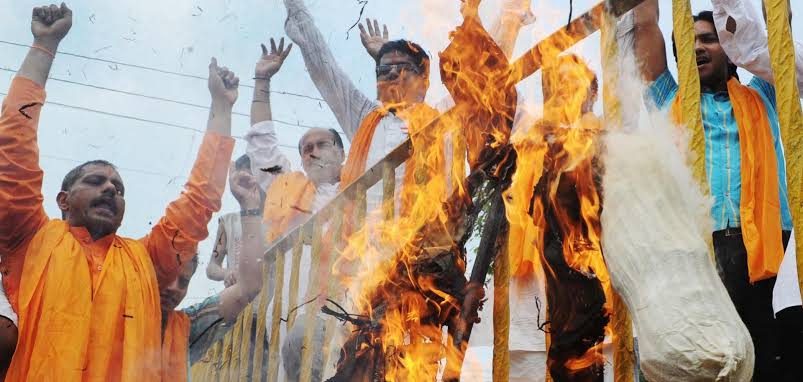India ranks highest in the world in terms of increasing mass murders by mobs and assaults on minorities. Majority of violent organizations are run by the Indian government and its respective political parties, giving them greater latitude to disregard political conventions and raising the risk of extremist acts. As extremist militancy became unprecedented in India’ the Central Intelligence Agency (CIA) of the USA categorized the ultranationalist Hindu organizations Vishva Hindu Parishad (VHP) and Bajrang Dal as “religious militant organizations” in its most recent publication of the World Factbook. The organization has classified them as political pressure groups, which apply political influence but their leaders are not aimed at getting seated in legislative bodies.
The World Factbook is released by the CIA every year to provide the US government with intelligence and factual information about other countries and their issues. It contains data on history, population, government, economics, energy, geographical areas, communications, transport, military, and international concerns. US intelligence community collaborates to develop the Factbook for US policymakers and nomination of Indian state-sponsored organizations is symptomatic of threat to US interests. The RSS, Hurriyat Conference, and Jamiat Ulema-e Hind are among other political pressure groups in India listed by the CIA. RSS has been defined as a “nationalist organization”, the Hurriyat Conference as a “separatist group” and the Jamiat Ulema-e Hind a “religious organization”.
VHP has been involved in illicit activities against minority groups, notably Muslims in India by playing an essential role in the riots that followed the Babri Mosque’s destruction in Ayodhya in December 1992, which resulted in the deaths of over 2,000 Muslims. In Gujarat State in 2002, amid anti-Muslim pogroms that resulted in the deaths of over a thousand Muslims, VHP additionally promoted violence and became well-known for participating in the lynching of Muslims (to death) through the Bajrang Dal, particularly in the name of punishment for suspected cow transportation. The extremist youth section of the VHP known as Bajrang Dal has a history of lynching and assaulting Muslims and is seen as a symbol of dread for Indian Muslims. According to a UK government investigation into the pogroms in Gujarat, “violence (in 2002) was planned months in advance by VHP. Furthermore, VHP claimed to have converted 5,000 individuals to Hinduism in 2002 and between 1982 and 1985 they converted around 66,000 people (mostly Muslims and Christians) to Hinduism. Similar to 2003, 12,857 people were converted to Hinduism in 2004, 3,727 of them were Muslims and 9,130 were Christians.
A sister group of VHP, Vishva Hindu Parishad America, actively promotes religious extremism, mostly against Muslims in the USA, and finances VHP, the organization’s equivalent in India. In order to foster communal and religious strife, it also finances schools run by a single teacher in India known as Ekal Vidyalaya, which are supported by the RSS. VHPA supported the VHP movement in India, which culminated in the destruction of the Babri Mosque in December 1992, by encouraging Islamophobia against Muslims and Christians and by inviting Hindu militant leaders from India, such as Ashok Singhal, a senior VHP leader with a history of anti-Muslim rhetoric, to their events. In response to their fears of Muslim oppression in India, the VHPA targets American Muslim politicians and opponents as well as human rights organizations like Amnesty International and the US Commission on International Religious Freedom. In June 2022, it referred to US Representative Ilhan Omar as a “radical Islamist” for speaking out against India’s declining religious tolerance.
Since Prime Minister Narendra Modi’s victory in the 2014 election, Hindu nationalist organizations have targeted Muslims and other minorities more often with anti-minority rhetoric and mob violence. Hindu nationalist hardliners want India to become a Hindu state where a fifth of the population is not Hindu and have publicly prompted assault against minorities, particularly Muslims and Christians. By 2050, India’s Muslim population, which is presently the second-biggest in the world, is expected to surpass the rest of the world.
Hindu nationalist-inspired assault against minorities has the potential to spark fresh waves of reprisal violence in the region, potentially harming US interests. The US administration views India as a stabilizing force in the area, but Hindu nationalist policies have a tendency to exacerbate present crises and spark new ones, which will ultimately have an impact on US policies towards India and South Asia as a whole.
Keeping in view the violence that has unfolded in Manipur in the last few months, international community must take into account the atrocities committed against Indian minorities at the hands of the BJP government. PM Modi’s government in India has turned most of the country’s minority-dominated regions into active battlegrounds and has so far not shown any real interest in mediating these ethno-religious crises. To say the least, the future of religious minorities in India will likely remain highly volatile in the foreseeable future.






